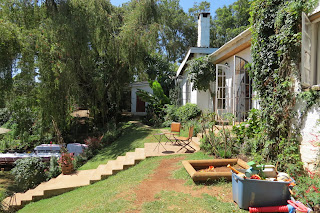2012-1-26 Brown’s Cheese Factory
We had purchased cheeses produced in Niarobi from the supermarket, and they were quite good. Today, we joined a group of parents from the International School of Kenya to visit Brown’s Cheese Factory in Limuru. It was not far from the Kiambethu Tea Farm which we had visited previously.
 |
| Rear graden |
The factory was set up in a few small buildings added to the original farm house back on a ravine filled with tall trees and shrubs. When we arrived, tables had been set up in the garden behind the house for us to have lunch. We saw a big black pig called Bacon mowing the grasses. The owner probably wouldn’t need to have a lawnmower. The owner started by giving us a demonstration of how fast the milk would coagulate with the help of rennet. He poured some milk in a steel pan, and then added some rennet. After half an hour, the milk had turned into jelly and could be cut into cubes like tofu.
 |
| The main facilities |
 |
| Testing the liquid content of the curd |
The area was mainly tea farming. The factory purchased their milks from small farmers in the area. Most of the farmer had about 5 cows, and produced about 25 litres of milk a day. They brought the milk back to the factory in containers. We were asked to put on a net over our hair, and to put on a white working uniform for sanitary purpose. First, we were shown the work area where the containers were being washed and cleaned. Next to the area was the main factory. It was about 25x50 ft. The main facilities were 3 big stainless steel tubs where the milks were left to turn into curd. There was a tap at the bottom of the tub to drain the excess liquid. A technician would take sample of the curd to decide if it was ready to be loaded into a cheese presser to squeeze out more liquids out of the curd. The cheese that came out could be turned immediately into mozzarella cheese. For other cheeses, more ingredients were added and the cheeses were put in a mould to let it solidified and formed the hard rind.
 |
| Cheese aging room |
The adjacent room was the aging room. It was a long 15x50 ft room with 3 row of shelving. The shelving on the wall had 6 shelves, and the one in the aisle had only 4. Cheeses were put on the shelves properly with date marked on the board. Cheeses were stacked not more than two. And some cheeses like giant sausages were hung in the middle shelves. Water was sprayed into the room to keep its high humidity. Mold could form on the rind of the cheeses, and they were wiped clean regularly. Mold was the most important thing to control in the aging room. Most molds would do no harms to the cheese. But the black colour molds was not allowed to appear. They only kept the cheese for several months in the aging room and then put them in the market. The holes in the Swiss cheese were caused by the air produced by the bacteria deliberately mixed in the cheese. The size of the holes was in proportion to the size of the cheese.
 |
| Sampling the cheeses |
There was a smaller aging room for brie and other cheeses that required more stringent controls. We only saw this room from its glass outside. After the completion of the tour, we were served with some samples of the cheeses produced by the factory.
More photos can be seen by searching "lku99999, photo" in Google.
No comments:
Post a Comment